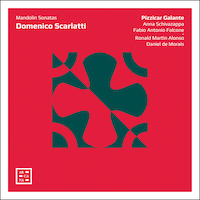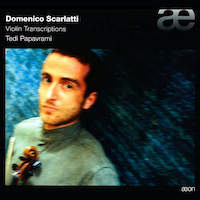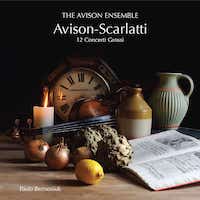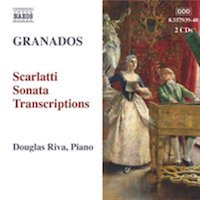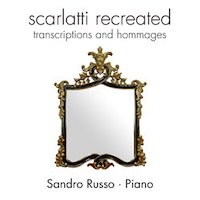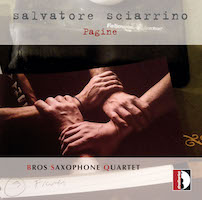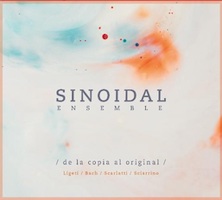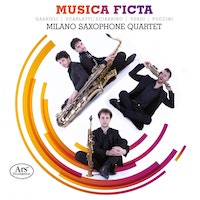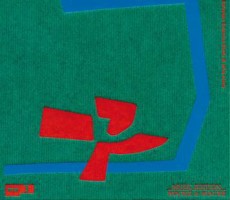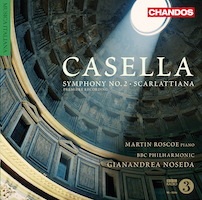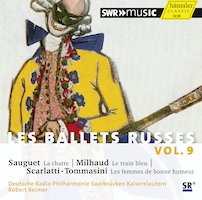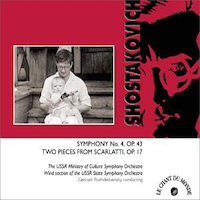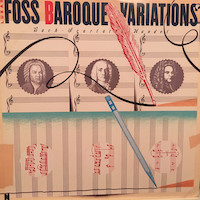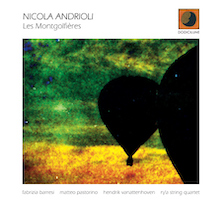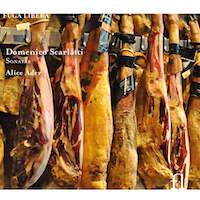(Dis)Arrangements 13. / Scarlatti para siempre 3.
|
Grant Chu Covell [January 2022.] 2021 was my Scarlatti year. I spun a lot of Scarlatti this past year (here and here) including all varieties of arrangements and digressions. A few piano transcriptions were mentioned back here. Scarlatti proved to be a fertile resource immediately after the first sonatas were published in the 1730s and ‘40s. It is fascinating to see which composers and performers felt it necessary to enhance the Baroque master, and which were content to simply orchestrate. I won’t get into releases for harp, accordion, multiple guitars or organ (except to mention that K. 255’s bird imitations can be quite effective on the king of instruments).
“Mandolin Sonatas.” Domenico SCARLATTI: K. 91, 77, 88, 89, 78, 35, 73, 81, 90, 85, 61. Pizzicar Galante: Anna Schivazappa (mand, cond.), Ronald Martin Alonso (gamba), Daniel de Morais (theorbo, guit), Fabio Antonio Falcone (hpsi, cond.). Arcana A115 (1 CD) (www.outhere-music.com). It’s likely that Scarlatti tried his hand at sonatas for solo instrument with continuo. Several of the extant keyboard sonatas (e.g.: K. 81, 88, 90 and 91) have distinct movements and treble parts which are essentially single lines. These may have originally been sonatas for a solo instrument with accompaniment. Pizzicar Galante offers K. 61, 73, 90 and 91 as a quartet of solo mandolin with continuo of viola da gamba, theorbo and harpsichord. Other sonatas are taken as mandolin with harpsichord for a simpler comportment. K. 91’s second movement, Allegro, is especially exciting with the full ensemble. Honestly, it’s hard to hear these as keyboard works after this treatment. As solo sonatas, these work better with the plucked instrument instead of violin or flute.
“Violin Transcriptions.” Domenico SCARLATTI: K. 54, 32, 466, 481, 11, 380, 87, 141, 426, 185, 9, 322. Tedi Papavrami (vln). Aeon AECD 0644 (1 CD) (www.outhere-music.com). Papavrami’s twelve transcriptions may not attempt anything more harmonically adventurous than what can be found in Bach’s sonatas and partitas, but Papavrami brings the technique required for Paganini and Ysaÿe into these arrangements. Where necessary, Papavrami simulates bass lines plus accompaniment using broken chords and grace notes, sometimes pizzicato to add color or to ensure upper notes can be held. K. 322 is a duet between a bowed upper line and left-hand plucking. Several familiar sonatas are here, such as K. 380, 87, 141 and 9. At first hearing these pieces sound mostly like Paganini, especially the lilting dance gestures of K. 380 and 9. Where the sonatas include Iberian colors such as in K. 141, Papavrami suggests Tartini’s Devi’s Trill. As a solo, K. 426, also the longest at 10:19, is quite effective.
Charles AVISON: Concerti Grossi after Scarlatti (1744). The Avison Ensemble, Pavlo Beznosiuk (cond.). Divine Art DDA21213 (2 CDs) (www.divineartrecords.com). Avison’s concertos after Scarlatti’s sonatas reveal how music spread in the 18th century. The English publisher Thomas Roseingrave met Scarlatti in Venice in the early 1710s and was impressed by the Italian’s keyboard skills. He returned to London with a sheaf of sonatas which he published in 1739/40. These pieces appealed immensely to Avison, who had studied with Geminiani. The English composer’s transformations are ingenious. It can be hard to pick out the original material. Leveraging the 30 Essercizi, Avison freely transposed, cut and changed tempos to build out his concertos, contributing movements of his own invention. For example, the opening Andante of Avison’s Fourth Concerto draws upon K. 12, but slowed considerably creating an entirely different mood. I’ve preferred the Avison Ensemble’s release because of its elegance, and because the notes indicate the movements’ sources sparing detective work.
“Enrique Granados: Piano Music, Vol. 9.” Enrique GRANADOS: Scarlatti Sonata Transcriptions. Douglas Riva (pno). Naxos 8.557939-40 (2 CDs) (www.naxos.com). “Scarlatti Recreated.” Carl TAUSIG: Capriccio in E major (arr. K. 20) (1860s); Sonata in C major (arr. K. 487) (1860s). Louis BRASSIN: Nos. 2 and 1 from Trois Morceaux pour le piano d’après D. Scarlatti (arr. K. 377, 525) (1879). Enrique GRANADOS: Nos. 7, 18, 5, 15, 12, 19 and 20 from Veintiséis Sonatas Inéditas para clave (arr. K. 102, 547, 541, 553, 534, 109, 211). Carl CZERNY: Sonata in the Style of Domenico Scarlatti, Op. 788 (1847). Ignaz FRIEDMAN: Pastorale and Gigue (arr. K. 446, 523) (1914). Charles-Valentin ALKAN: Duettino from Esquisses, Op. 63 (1861). Marc-André HAMELIN: Étude VI: Esercizio per Pianoforte, “Omaggio a Domenico Scarlatti” (1992). Jean FRANÇAIX: Hommage à Domenico Scarlatti from La Promenade d’un Musicologue Eclectique (1987). Raymond LEWENTHAL: Toccata alla Scarlatti (1975). Michael HABERMANN: Homage to Domenico Scarlatti (Diversion after Sonata in C, L. 104, K. 159) (1975). Sandro Russo (pno). Musical Concepts MC 149 (1 CD) (www.musicalconcepts.net). Czerny’s edition of 200 sonatas appeared in multiple volumes between 1838 and 1840. The first modern Scarlatti edition was edited by Alessandro Longo and was published by Ricordi in eleven volumes between 1906 and 1913. Piano virtuosi and pedagogues in the Romantic and early Modern eras felt it necessary to update Scarlatti for the piano. As the instrument became more modern, it could handle more chords, notes and dynamics. Why would you want to play quietly on a such an innovation? Today’s players have no issue with the style or inherent challenges of offering Scarlatti’s keyboard sonatas as is. Scarlatti’s habit to jump to different keys without preparation also demanded editorial explanation. A single left hand bass note could be reinforced at the octave, and thirds and other chord notes could be added. A passage of eighth notes could glitter into a second octave if recast with sixteenths, and ornaments could be spelled explicitly with grace notes and splashing arpeggios. Granados was tasked to create his edition before the first modern complete editions. His collection of 26 sonatas labels them “unpublished” as they were at that point unknown. True to his times, he took liberties, adding octaves, thickening chords, repeating notes and spelling out ornaments. Granados keeps Scarlatti’s harmonies for the most part, rarely adding chromaticism. His accompaniments are more active, single whole notes turn into arpeggios and counter melodies; in the B-section and development, Granados will thicken the argument. He also gently emphasizes the Iberian hints without becoming too garish. Today it is accepted that of the 26 sonatas, only 24 are Scarlatti’s: K. 520, 521, 522, 518, 541, 540, 102, 546, 190, 110, 534, 535, 553, 555, 554, 547, 109, 211, 552, 537, 528, 139, 481 and 536. No. 10 in Granados’ edition is now attributed to Francisco Courcelle, whereas the original composer of No. 13 remains still unknown. Considering Kirkpatrick’s chronological numbering, we see that the manuscripts Granados worked from (a title page attributes them to the Royal Family) contained predominantly later sonatas. Riva’s double set offers all 26 of Granados’ transcriptions. The additions are not unlike an improvising pianist. Scarlatti is definitely still here. Riva provides the right amount of restraint, even as Granados adds dynamics, fancier octave figurations, and fleshy Romantic swells. It’s an interesting lens through which to view Scarlatti’s late work. Russo’s glittering recital offers comprehensive Scarlatti transcriptions and pieces inspired by the Neapolitan-born composer. The two Tausig selections are bright. K. 487 maintains its leaping, optimistic shape. Brassin was known in his day for transcriptions of Wagner, and his Scarlatti adds secondary voices and texture. Czerny’s Sonata adheres to ternary from, but offers so many notes in its Romantic harmony. Friedman’s K. 446, “Pastorale,” turns the corner into the 20th century echoing Rachmaninoff, whereas K. 523 maintains its Classical harmony despite chromatic ornaments. Alkan’s Duettino lives within a four-book collection totaling 49 pieces. The debt to Scarlatti is evident in the lean harmony. Hamelin’s spirited Étude may be the most familiar item. It’s a wrong-note sendoff of Scarlattian figurations imitating the ternary form and the difficult hand crossings. Likewise Lewenthal’s Toccata and Habermann’s parody of K. 159 reveal contemporary composer pianists poking fun at Scarlatti’s distinctive style. Françaix’ Scarlatti Hommage embeds Beethoven and Mendelssohn. Russo provides seven Granados transcriptions.
“Pagine.” Salvatore SCIARRINO: Pagine (1998). Bros Saxophone Quartet: Gerard McChrystal, Antonio Felipe Belijar, João Pedro Silva, Mario Marzi (sax). Stradivarius STR 37042 (1 CD) (www.stradivarius.it). Salvatore Sciarrino has plumbed Scarlatti in several collections, fashioning string quartet and saxophone quartet transcriptions, as well as incorporating orchestral arrangements into larger compositions. Pagine is a 1998 “concerto” of saxophone arrangements. Gesualdo, J.S. Bach, Mozart, Cole Porter, Gershwin and some anonymous 14th century tunes are mixed in with three Scarlatti sonatas (K. 532, 206 and 120). Scarlatti on saxophone can be quite joyous. Mozart’s familiar Adagio from the “Gran Partita” Serenade, K. 361, is quite lovely this way. Of course, there are no hand crossings in this K. 120.
“De la copia al original.” György LIGETI: Seis Bagatelles (1953; arr. Fabio OEHRLI, 2007). J.S. BACH: Italian Concerto, BWV 971 (1735; arr. Katsuki TOCHIO, 1997). Salvatore SCIARRINO: Canzioniere da Scarlatti (1998). Sinoidal Ensemble: Ana Lencina Sánchez, Elisa Urrestarazu Capellán, Fernando José Laguna Bermúdez, José Miguel Cantero Tomás (sax). Sinoidal MU1502-2018 (1 CD) (www.sinoidal.com). “Musica Ficta.” Giovanni GABRIELLI: Canzon seconda (arr. Milano Saxophone Quartet, 2016). Salvatore SCIARRINO: Canzioniere da Scarlatti (1998). Giuseppe VERDI: String Quartet (1873; arr. Alberto DI PRIOLO, 2017). Giacomo PUCCINI: Crisantemi (1890; arr. Milano Saxophone Quartet, 2016). Milano Saxophone Quartet: Livia Ferrara, Damiano Grandesso, Stefano Papa, Massimiliano Girardi (sax). Ars Produktion ARS 38 207 (1 SACD) (www.ars-produktion.de). Canzoniere da Scarlatti (1998) arranges six sonatas (K. 208, 350, 404, 209, 255, 359, 153) for saxophone quartet. Perhaps reflecting Nationalistic pride, Sciarrino (and his publisher) refer to the sonatas by their Longo numbers. These are literal arrangements, and to my ear, both ensembles seem unfamiliar with the keyboard versions, especially the Milano foursome who find different tempos and creatively reimagine Sciarrino’s specified appoggiaturas and grace notes. Quite possibly these arrangements would charm more if you were unfamiliar with the originals. K. 255 is especially entrancing in the wind arrangement. A passage in K. 359 prefigures Beethoven. Comparing the programs, Sinoidal builds towards the Scarlatti, whereas the Milano group must subsequently navigate the unexpected Verdi and Puccini. Sciarrino’s string quartet transcriptions include Esercizi di tre stili (1999) with six sonatas: K. 443, 255, 208, 188, 359 and 350, and L’esercizio della stravaganza Généalogie (2014), a hefty two-dozen collection: K. 202, 120, 132, 380, 208, 29, 531, 262, 27, 239, 193, 264, 513, 519, 24, 490, 268, 394, 491, 127, 492, 474, 105 and 487. (K. 474 and 105 are also featured in Storie di altre storie as Stravinsky harbingers.) Perhaps not an evident first choice, but the arrangements for sax quartet are more satisfying than the arrangements for string quartet. This is probably due to the saxophones’ simpler articulations, and that strings by nature want to provide articulation often at odds with the keyboard originals.
Salvatore SCIARRINO: Efebo con radio (1981)1; Il giornale della necropoli (1999-2000)2; Autoritratto nella notte (1982)3; Storie di altre storie (2004)4. Sonia Turchetta1 (voice), Teodoro Anzellotti2,4 (accordion), WDR Sinfonieorchester Köln, Kazushi Ono1,3,4, Lucas Vis2 (conds.). Winter and Winter 910 114-2 (1 CD) (www.winterandwinter.com). Storie di altre storie (2004) for accordion and orchestra embeds K. 474, 105 and 262. Sciarrino visits Scarlatti to show us how modern he was. Indeed the joke in the first movement of Storie (which also incorporates Mozart and Machaut) is how one Scarlattian gesture can be made to sound like Stravinsky. The second and third movements of Storie are more straightforward confections. We find an additional Stravinsky joke in the central movement and the final movement erupts into a brilliant celebration. In 2015, I said: “The last two movements center around one Sonata each. K. 105 and K. 262 emphasize the Spanish flavor, and I hear references to Respighi, even Berio’s treatment of Boccherini. I imagine we’re treated to a realization of how one composer can’t hear another’s work without thinking of tampering with it.” * * *
Revisting the 1926 Scarlattiana suggests Casella was mythologizing Scarlatti to suit his antiquarian needs. Attempting to forge a triumphant Italian sound for the 20th century, Casella leaned heavily upon the past. His current obscurity suggests that his gambit failed (although he was an important educator). Not unlike Respighi’s Ancient Airs and Dances, Casella’s orchestra and solo piano fling bits and pieces of sonatas (eighty or ninety depending upon whose program notes you read) conjuring an unspecified era when everyone was happier and life was simpler. The five-movement divertimento was written in Rome when the neoclassical style was something most every composer had to try (Stravinsky’s Pulcinella premiered in 1920). The line separating caricature from copy is blurry indeed. Scarlattiana skitters around that boundary, often frivolous, especially when Casella emphasizes Spanish contours or adds percussion emphasis. A decade before, Vincenzo Tommasini orchestrated some Scarlatti for Les Ballets Russes, creating Le donne di buon umore (1916). If Casella fractures Scarlatti for his own aims, Tommasini simply orchestrated several sonatas, among them K. 2, 435, 87, 430, 455 and 30. Several recordings offer excerpts from the ballet in the form of five or six-movement suites. Tommasini may enforce repeats, but otherwise his transcription is straightforward which permits Scarlatti’s elegance to speak for itself. How can K. 435 not charm? (Legend has it that Scarlatti had a cat named Pulcinella who would walk on the keyboard, and that the theme of K. 30, the so-called “Cat’s Fugue,” represents such a feline stroll.) In 1928, Shostakovich arranged K. 9 and 20 for winds and timpani, published as his Op. 17, and rarely recorded. For K. 9, “Pastorale,” the melody is tossed around the ensemble relatively literally, whereas for K. 20, “Capriccio,” Shostakovich provides trombone slides and the band visits the circus. Lukas Foss’ 1967 Baroque Variations, in three movements, considers Handel (Larghetto from Op. 6, No. 12), Scarlatti and Bach (Prelude from Solo Violin Partita No. 3) in turn. The center Scarlatti movement distorts K. 380. An offstage harpsichord is overwhelmed as instruments smear and repeat on bits of the sonata at different concurrent tempos. You could piece together the entirety of the sonata from the harpsichord part. I recall listening to the 1985 Nonesuch LP with glee. Foss was channeling Spike Jones and murdering a few classics. Of course, the ’85 Nonesuch release enabled such a perspective by offering the originals on the B-side. The initial 1968 LP paired Foss with Cage’s Concerto for Prepared Piano and Orchestra (1950-51). Years later, the piece strikes me as Foss’ modernist shorthand, an attempt to create something relatively easy for an orchestra to play (easier than Babbitt or perhaps Cage) but would still demonstrate contemporary chops. * * *
Adding strings to piano, Nicola Andrioli wraps his 2014 “Les Montgolfières” with a jazz arrangement (piano plus strings) derived from K. 208 (Dodicilune ED332). Scarlatti’s tune does not easily yield to the surrounding string harmonies. I can’t resist mentioning the visual pun of the cover to Alice Ader’s 2010 release of 20 sonatas on piano, Fuga Libera FUG 574 (K. 12, 144, 99, 441, 373, 32, 43, 202, 40, 225, 8, 70, 95, 56, 244, 83, 25, 69, 85 and 59). One of the important collections of Scarlatti sonatas was purchased by the Conservatory in Parma, Italy, in 1899. These 463 sonatas in fifteen volumes remain a key source for authenticity and understanding the sonatas chronologically. (In his survey, Grante proceeded through the sonatas following their order in the Parma edition.) Other than Scarlatti, Parma is also known for its ham.
Alkan, Andrioli, Avison, Bach, Brassin, Casella, Czerny, Di Priolo, Foss, Francaix, Friedman, Gabrielli, Granados, Habermann, Hamelin, Lewenthal, Ligeti, Oehrli, Puccini, Scarlatti, Sciarrino, Shostakovich, Tausig, Tochio, Tommasini, Verdi
[More (Dis)Arrangements, Grant Chu Covell]
[More
Alkan, Andrioli, Avison, Bach, Brassin, Casella, Czerny, Di Priolo, Foss, Francaix, Friedman, Gabrielli, Granados, Habermann, Hamelin, Lewenthal, Ligeti, Oehrli, Puccini, Scarlatti, Sciarrino, Shostakovich, Tausig, Tochio, Tommasini, Verdi]
[Previous Article:
Concerto Concentrations 6.]
[Next Article:
Four Poems]
|
